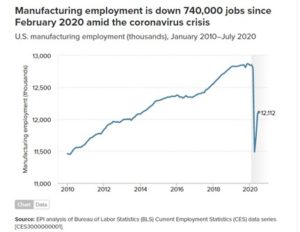Since 2017, Hundreds of Thousands of American Jobs Were Offshored, Trade Deficit Is Up 22%
Since 2017, hundreds of thousands of additional U.S. jobs have been offshored and the trade deficit has grown, according to U.S. Department of Labor and Census Bureau data:
300,000 More American Jobs Lost to Trade
- More than 300,000 American jobs have been lost to offshoring and trade during Trump’s presidency, as certified by the Labor Department. The Economic Policy Institute said total trade job loss is much higher — estimating 700,000 jobs lost to China alone in Trump’s first two years.
- Nationwide, 311,427 American jobs have been government-certified as lost to trade since 2017, with 202,543 explicitly listed as offshored, but the total number is higher. These numbers represent only the workers that the Labor Department approved for Trade Adjustment Assistance (TAA), a voluntary program that workers must know about, apply for and then prove that trade caused their job loss in order to receive assistance. And, the TAA numbers do not include all 2019 or most 2020 because of processing lags.
- Since 2017, General Motors closed U.S. plants and moved popular vehicle lines to Mexico; Ford announced its new Mustang electric SUV will be made in Mexico; Boeing offshored 5,800 jobs, General Electric offshored 2,046, and United Technologies offshored 1,572 jobs. The Machinists and Steelworkers have lost dozens of facilities to offshoring during this period.
- Although then-president-elect Donald Trump promised to stop Carrier workers’ jobs from being offshored, almost 600 of the union workers at Carrier’s Indianapolis plant lost their jobs and all 700 of Carrier’s Huntington Indiana jobs were offshored to Mexico. Carrier parent firm United Technologies offshored at least 1,572 jobs according to Trade Adjustment Assistance data.
- Michigan’s trade-related job loss has more than doubled over the last three years. Michigan has hemorrhaged jobs to offshoring with a 211% increase in trade-related job loss. (From 2017-2019 TAA-certified job loss was 15,675 compared to 7,428 for 2014-2016.) It’s getting worse: Michigan suffered a 308% increase in trade-related job loss in 2019 over 2018.
The trade deficit is 22% higher than in 2016
- U.S. Census Bureau data show that the U.S. trade deficit in the first eight months of 2020 is 22% higher than it was during the same period in 2016. This is especially troubling because trade volumes crashed 15% due to the COVID-19 pandemic. (Inflation adjusted: $424.8 billion trade deficit January-August 2020 compared to $347 billion during the same period 2016.)
- In August 2020, the U.S. had the largest monthly goods trade deficit ever recorded and the largest overall monthly trade deficit since August 2006.
- The August 2020 surplus in services trade was the smallest since January 2012, at $16.76 billion.
- The eight-month 2020 deficit in manufactured goods is 12% higher than in 2016.
The manufacturing sector expansion that began in 2016 flattened in 2018, with significant declines starting early in 2019
- Trump didn’t “create” a manufacturing boom. The U.S. Institute for Supply Management’s Purchasing Managers Index (PMI), a gold standard measure for the sector’s status, shows manufacturing growth began in 2015 and continued into 2018. The PMI data show that the manufacturing upswing began to flatten in 2018 and began a decline in late 2018 that continued through 2019 – all well before the COVID-19 crisis.

U.S. Institute for Supply Management Purchasing Managers Index Data
- The U.S. has not experienced a “blue-collar job boom.” Annual average manufacturing job gains during the entire 2010-2019 recovery was 166,000, which accounts for the 500,000 gain in U.S. manufacturing jobs from 2016 to 2019. Since 2017, there has been no jump relative to prior years, and total gains account for a small fraction of the 4.5 million manufacturing jobs lost since 2000.
- More workers filed for government aid for trade job loss through the Trade Adjustment Assistance program in 2019 than in 2017, per the 2019 annual report from the Labor Department. (There were 1235 TAA filings in 2019 versus 1091 TAA filings in 2017.) The number of eligible workers for TAA has remained high during Trump’s presidency: 88,000 in 2019; 77,499 in 2018; and 95,505 in 2017.)
- Mishandling of the COVID-19 crisis has wiped out 750,000 American manufacturing jobs. See here for live version of the Economic Policy Institute graphic below that shows jobs per month.

U.S. has created new incentives to offshore jobs
- The 2018 tax law created new incentives to offshore jobs, with a 21% corporate tax rate for income earned domestically, but a 10.5% tax rate for profits earned offshore.
- The “Phase-One” Trump-China trade deal made it safer and easier for big corporations to offshore with new investor and intellectual property protections for firms that move production to China. But there’s nothing in the deal to end forced labor in China or require basic worker rights or environmental protections to stop the race to the bottom. The agreement also lacks disciplines against China’s massive subsidies, which make it impossible for U.S. firms to compete with Chinese products.
####